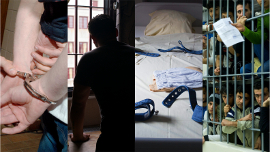During the visit, the CPT’s delegation reviewed the treatment of persons detained by the police and examined in detail the situation of female and juvenile prisoners, as well as the measures taken in response to the Committee’s recommendations made in the report on the 2009 visit as regards life-sentenced prisoners and inmates held in high-security units.
The majority of the persons met by the delegation who were or had recently been detained by the police made no complaints in respect of their treatment by police officers. Nevertheless, the delegation did receive a number of consistent and credible allegations of physical ill-treatment by police officers (including from several juveniles), consisting of slaps, punches and kicks to various parts of the body. In addition, some detained persons were purportedly warned not to complain to their family or a lawyer about the ill-treatment to which they had allegedly been subjected. The delegation also received a number of complaints about verbal abuse (including of a racist nature).
The CPT also describes certain individual cases of alleged police ill-treatment and makes several comments concerning requirements for an effective investigation into such allegations. In their response, the Slovak authorities provide an update on the investigations carried out into such cases.
Material conditions in custody cells in the police establishments visited were, on the whole, satisfactory. However, several of the police stations visited had small holding facilities destined for temporary placement of persons deprived of their liberty (so-called “designated areas”) which were occasionally used for overnight placement of apprehended persons. Some of them were cage-like cubicles, others were small rooms, equipped only with one or two fixed stools or a small bench. The Committee recommends that, due to their small size (sometimes a mere 2m²) and inadequate equipment, these facilities should not be used for holding persons for more than a few hours and never overnight. In their response, the authorities indicate that a new order will be issued to this effect by the Police President.
As regards prisons, the vast majority of prisoners interviewed by the CPT’s delegation made no allegations of physical ill-treatment by prison staff. That said, the delegation did receive a few allegations of physical ill-treatment and verbal abuse of inmates by members of staff in some of the establishments visited.
The Committee notes with concern that no systematic modification of the approach towards life-sentenced prisoners has been made since the 2009 visit. The CPT thus reiterates its recommendation that the Slovak authorities move away from the current policy of having life-sentenced prisoners locked up for most of the time in their cells, integrate them into the mainstream prison population and develop purposeful out-of-cell activities of a long-term nature. In their response, the Slovak authorities provide information on new rules (in force as from 1 January 2014) which allow life-sentenced prisoners to progress through the prisoner classification system with the ultimate aim of being placed in the general prison population.
Positive comments are made by the Committee about the regime offered to sentenced juveniles at Sučany Prison and sentenced women at Nitra-Chrenová. However, the regime of remand prisoners (including juveniles) and of sentenced prisoners held at Prešov Prison was found to be unacceptable. Most of the prisoners concerned were usually locked up in their cells for up to 23 hours per day, without being offered any purposeful out-of-cell activities.
A total absence of organised activities was also observed by the CPT in the high-security department of Leopoldov Prison. The Government response lists a number of measures which are expected to be implemented in the near future with the aim of remedying the situation. Further, the CPT was concerned to find once again that several prisoners accommodated in this department suffered from learning disabilities and/or showed clear signs of serious mental disorders. In the CPT’s view, a high-security department is not an appropriate place for managing such prisoners who should be cared for and treated in an environment which is suitably equipped and has sufficient qualified staff to provide them with the necessary assistance.
In most of the prisons visited, material conditions of detention were on the whole adequate. However, some of the cells at Nitra Prison were in a very poor state of repair and their size was clearly insufficient for the number of inmates they could hold (e.g., up to six inmates in a cell of some 11m²).
The visit report and government response have been made public at the request of the Slovak authorities and are available on the CPT's website: http://www.cpt.coe.int.
2014 News
The Council of Europe’s Committee for the Prevention of Torture and Inhuman or Degrading Treatment or Punishment (CPT) published today the report on its September/October 2013 visit to the Slovak Republic, together with the response of the Slovak authorities.
25/11/2014
- Diminuer la taille du texte
- Augmenter la taille du texte
- Imprimer la page

Preventing torture in Europe
www.cpt.coe.int


